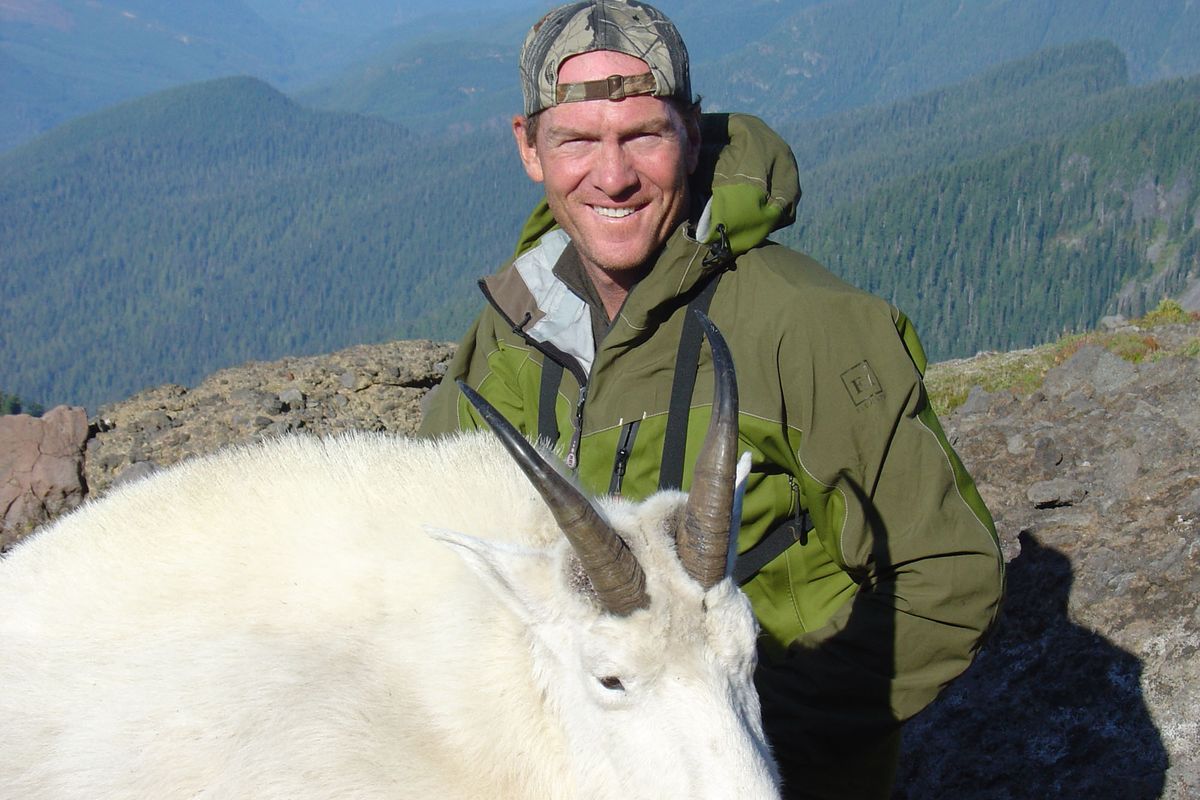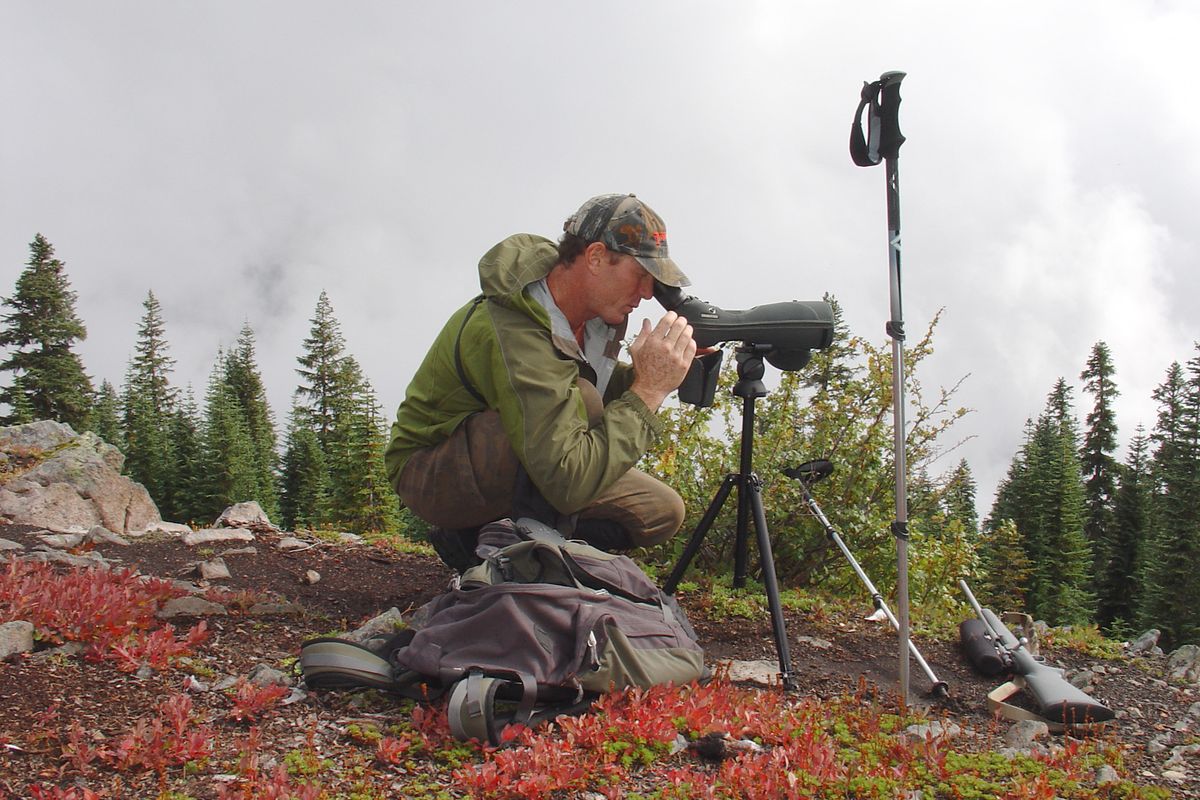Hunter has blueprint for perfect goat hunt
Hunter has blueprint for perfect goat hunt
After bagging his record-book mountain goat, Chris Culbertson signed up for a mountaineering school.Photo courtesy of Chris Culbert (Photo courtesy of Chris Culbert)
There’s nothing fancy about the mountain goat horns on a cheap plaque, which Chris Culbertson will display this week at the Big Horn Outdoor Adventure Show.
But the effort behind the trophy is first-class.
His taxidermist hasn’t yet had time to do the life-size mount of his September prize, so the Deer Park hunter is bringing just the 12-year-old billy’s horns: 10¼ inches long, 6 inches around the bases – among the top-15 largest recorded by hunters in Washington.
Odds for drawing a goat permit in Washington are hundreds or thousands to one, depending on the unit and whether you’ve accumulated bonus points from applying unsuccessfully in the state’s lottery tag drawings for a decade or more.
Culbertson’s homework and dedication for bagging the experience of a lifetime began with his commitment to getting the permit.
He’d already learned that Washington had some units only recently opened to hunters, boosting the chances of finding old trophy goats.
“I bought 300 raffle tickets at $5 a pop,” he said, referring to Washington’s program that offers a premium goat hunting opportunity each year to the winners of two raffle tags that raise funds for mountain goat management. “That gave me better odds than the regular tag drawing.”
The 47-year-old greenhouse-nursery operator knew he couldn’t leave the fitness factor to wait until he learned whether he drew a permit. The drawing was Aug. 1 and the season opened Sept. 1.
“You have to backpack in to hunt where mountain goats live and it’s demanding,” he said.
“I started training for the Spokane Marathon last summer. By the time I learned I’d drawn the raffle permit, I was already running 10 miles a day.”
The raffle permit gave him the privilege of hunting virtually any unit in Washington where more than one tag was being offered. So he pored over the data available in state hunter surveys and Boone and Crockett Club records.
“Of the 50 or so B&C goats taken in Washington, all but four came from north of Interstate 90 in the North Cascades,” he said, explaining how he began narrowing his search.
He also invested time on the telephone.
“After talking to wildlife biologists, I discovered that part of a newly opened unit on Mount Baker hadn’t been hunted in 20 years,” he said. “I knew there would be big billies there.”
He postponed his hunting until the third week in September, the earliest he could be sure the goats would have developed their full winter coat.
Culbertson was going all out for this opportunity, hopeful with plans for a full-specimen mount to honor the animal and the hunt.
Essential to the effort was carefully selecting his minimal backpacking gear and coming up with a capable and dependable backcountry partner.
Kim McCauley had no permit to hunt, but he supported Culbertson with his backpacking skills and alpine travel savvy.
“A friend like that is a godsend,” Culbertson said.
Their first five-mile foray up Baker’s volcanic slopes put the hunters in view of dozens of goats, but weather and poor visibility shooed them to lower elevations.
On the way out, he met another hunter, the only other hunter with a goat tag for that unit.
“You’re the raffle guy, my worst nightmare,” the man said, leaving no question he was disappointed to have competition.
“The guy said he’d been putting in for the permit for 20 years,” Culbertson recalled.
Since he could hunt almost anywhere, Culbertson graciously offered to scout a different area.
As a gesture of thanks, the other hunter tipped Culbertson to a user-made trail that headed into an area where he’d seen big billy goats outside of his limited hunting unit.
“My base camp is a pickup camper, so moving is easy,” Culbertson said.
Before following up on the hunter’s tip, Culbertson scouted an area blessed with an official maintained trail, confirming what biologists had warned: “It’s one of Mount Baker’s most popular hiking trails,” he said.
“We saw more than 200 hikers in a single day. Most of them were less than impressed when they saw the rifle barrel poking from the top of my pack.”
Even though he saw more than 100 goats that day, he chose not to hunt there.
“I hiked a ways with a backpacker and she was surprised I was hunting there because she’d never seen any goats,” he said. “I pulled out my spotting scope and showed her 52 goats on one ridge.”
Backpackers don’t carry spotting scopes, he noted: “They don’t know what they’re missing.”
But he chose to hike out and look for another spot.
“Ten years ago, I might have hung in there and hunted, but I didn’t want to alienate some backpackers to hunting by exposing them to a dead goat,” he said.
The next day, Culbertson and McCauley made the commitment to hike more than five miles on a sketchy user-made trail that gained a whopping 3,000 feet of elevation.
“It was worth it,” he recalled, describing their campsite in an alpine basin at 7,000 feet facing rock cliffs, snowfields and glaciers. We were in God’s country, and I saw the first goats before we even had the tent up.”
Through the spotting scope, he found several billies, including a large one wearing a radio collar.
“The billies were on a cliff above a glacier, so I stalked behind a near ridgeline to just beneath the glacier,” he said. “The closest I could get was 950 yards.”
As he suspected, the goats began moving lower on the slope in the afternoon to feed, giving him a chance for a stalk.
“It was amazing where they spent the day, up there where ice chunks were calving off above them,” he said.
Patience and planning paid off late that day, when Culbertson was able sneak through boulder fields and gullies and find the goats again. Late in the afternoon he finally inched over a ridge undetected to within 70 yards of the billies.
He studied them for five minutes before the big billy spotted him and started moving away.
Culbertson knew it was now or never. Boom.
He worked well into the darkness field dressing his prize before scrambling back down to his camp.
“Freezed-dried food never tasted so good,” he said. “Unlike virtually every other game animal I’ve taken, you don’t go after goats for their meat. A nanny can be good, but billies are not.”
As he prepared the next day for the brutal hike out under the burden of a 100-pound pack, he spotted another big billy on the slopes above.
He took several shots at that one, too – “with a camera, through the spotting scope,” he said.
Later he learned from biologists that his billy was 12 years old, but the GPS collar they’d attached to study its movements stopped functioning years ago.
What’s next for Culberton?
“I signed up for the Spokane Mountaineers’ Mountain School,” he said. “I went out on a glacier without crampons during the hunt and I knew I needed some training.
“My next goal is to climb Mount Rainier.”

